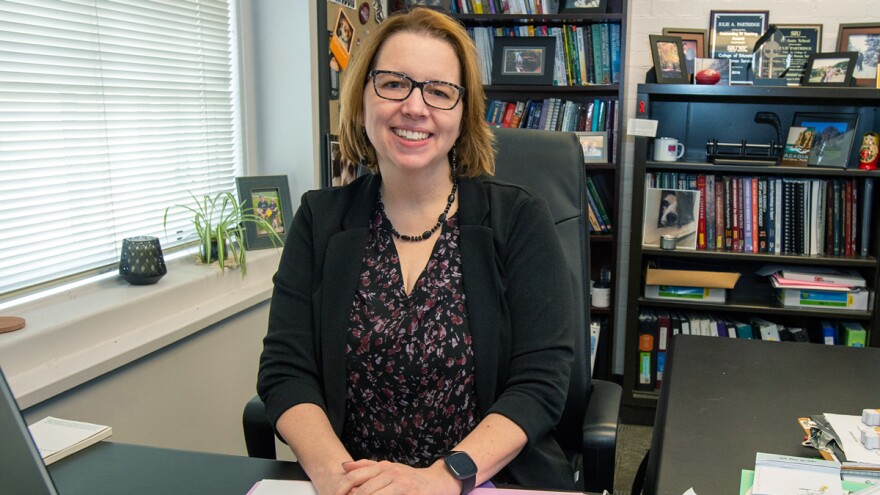CARBONDALE, Ill. — Julie Partridge, graduate program director and professor of sport and exercise psychology in Southern Illinois University Carbondale’s School of Human Sciences, knows full well how sudden and dangerous a blood clot can be. As March is Blood Clot Awareness Month, she shares her professional and personal expertise about clots, their sometimes deadly effects and their prevention. She notes that clots kill more than 100,000 Americans annually – more than deaths from AIDS, breast cancer and car accidents combined. Partridge said another 800,000 people in the United States are diagnosed and treated each year.
“Blood clots are often associated with older adults and individuals who are inactive, but they can happen to anybody,” Partridge said. “Some well-known athletes who have experienced blood clots include former professional tennis star Serena Williams, former NBA player Chris Bosh, multiyear Olympian and former swimming world record holder Katie Hoff and Trey Smith, starting right guard for the Kansas City Chiefs. But blood clots are typically very treatable if caught in time.”
Partridge, who can be reached at jpartrid@siu.edu or 618-453-3119, is by career a proponent of exercise and fitness and serves as the NCAA faculty athletics representative for the university. But in January 2019 after returning from a holiday trip to visit family, she encountered intense pain in both legs, which she attributed to sciatica. Then, while walking from her office in Davies Hall to her car she experienced extreme breathlessness, nearly passing out and arrived at her car drenched in cold sweat and feeling not “right.” A trip to the emergency room led to a diagnosis of a massive saddle pulmonary embolism (PE), a blood clot in the lungs that “saddled” across the main pulmonary artery branches into both lungs. Quick surgery blasted the clot apart. She was home two days later, returning to work shortly thereafter.
Experience led to expanded knowledge
However, Partridge said her full physical and mental recovery “took much longer” and as part of her efforts to return to normalcy, she became active in both clot research and advocacy.
“This very scary diagnosis and health experience led me into a new line of research on psychosocial factors associated with exercising after venous thromboembolism, including the perceived barriers, social support and information about physical activity upon diagnosis,” she said. “This research line is one that is personally meaningful and very needed, as there is very little existing research on this topic.”
From a personal perspective, she knew she wanted to become more engaged with exercise and physical activity after her treatment, which is typically recommended for clot survivors, but she was very nervous about being out of breath as that was the major PE symptom she had felt.
“It was difficult for me to learn to be OK with experiencing and feeling those body sensations again,” Partridge said. “Because I have an academic background in motivation and adherence, this felt like an area that I could try to help understand not only because of my experience but through experiences of other survivors as well.”
Facts about clots
Partridge said her research led her to several discoveries about blood clots. First, it’s important to know the signs and symptoms, which include:
- Swelling, tenderness and/or discoloration of the legs
- Shortness of breath
- Chest pain or racing heart
- Passing out
Other facts to know about blood clots:
- Deep vein thrombosis (DVT) occurs when a clot forms in one of the body’s major veins, most often in the legs, but it can also occur in other parts of the body, including the arms and pelvis. PE occurs when all or part of the clot breaks off and travels through the bloodstream to the lungs
- About one in five blood clots are related to cancer and its treatments
- Approximately half of all blood clots occur during a hospital stay or surgery or within three months afterward, and many can be safely prevented
- PE causes about 20% of all childbirth related deaths in the U.S.
- Between 2% and 5% of PE cases each year are “saddled” as hers was
Sharing her expertise
Partridge has not only researched blood clots, but she has become involved in advocacy work with the National Blood Clot Alliance (NBCA) and currently serves as the vice chair of the organization’s board of directors.
“This has allowed me to try to educate about and advocate for this important topic, and I’m happy to speak with individuals or groups who may be interested in learning more,” Partridge said.
She spoke about the psychological impact of exercise on blood clot survivors as part of a panel discussing patient perspectives on care and recovery from clots earlier this month at the 15th annual John Hopkins Medicine VTE Symposium. She will be traveling to Washington, D.C. later this month with a group of survivors and advocates to lobby for an increase in funding to the Centers for Disease Control for blood disorders, including clots.
###







